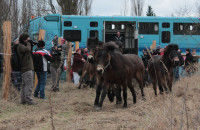Historical event: wild horses are returning to Central Europe after centuries

A first herd of fourteen wild horses has enriched Central European nature today. A non-state reservation in a former military training area in Milovice became their new home. It is the first and only herd of wild horses in Central and Eastern Europe.
The wild horse, which belongs to the original animal species in Europe, was exterminated by humans on the continent. Wild living horses, however, survived in a rough mountain area in Exmoor in Great Britain, in a plateau with a lot of marsh and moorlands. The first written mention of them goes back to year 1086 and they thus belong to the oldest horse breeds in Europe. For centuries local people simply called them „wild horses“ and in royal hunting they were traditionally stated on wild game lists. A relatively short time ago, in the 19th century, there began to use the name Exmoor pony for them, sometimes also Celtic pony.
„The return of wild horses ranks among the most significant events of the history of nature conservation in Central Europe,“ stated Dalibor Dostal, the director of the European Wildlife organisation. This non-profit organisation prepared the project for the return of wild horses to the Czech Republic in cooperation with experts of The Biology Centre of ASCR, South Bohemian University, Charles University and The Institute of Vertebrate Biology of ASCR.
„Genetic and archaeological analyses from the past indicate that only the Exmoor pony corresponds the best with its appearance, size and colouration to the original wild horses of Central and Western Europe. Any other breed of this area has not lived for the last thousand years in free nature, in fact, without any human influence and without any crossbreeding with other breeds. These horses have never been used for draught, nor for riding, their only task was to maintain local pastures by grazing rough vegetation,“ explains Dalibor Dostal.
The wild horses will also have the same role in the new home. Their task will be to graze rare steppes and remaining rich meadows and in specified localities to stop a loss of the open and half-open landscape which is necessary for the survival of disappearing species of butterflies, numerous species of birds, reptiles and other endangered vertebrates, but also for countless plants.
The wild horses will also have the same role in the new home. Their task will be to graze rare steppes and remaining rich meadows and in specified localities to stop a loss of the open and half-open landscape which is necessary for the survival of disappearing species of butterflies, numerous species of birds, reptiles and other endangered vertebrates, but also for countless plants.
The experts chose suitable horses after several years of careful analyses. During them they gradually excluded unsuitable breeds, which despite frequent proclamations have nothing in common with wild horses; for example the Polish konik or German Heck horse. Besides Exmoor ponies, at the beginning they also considered using huculs, which are also often stated to be close relatives of wild horses in the literature. „A deeper analysis, however, showed huculs are in fact a mixture of several diverse breeds, including Arabian horses and the Noriker. What is more, it is a relatively young breed, which came into being by intentional crossbreeding for the Austro-Hungarian army‘s needs,“ says Miroslav Jirků of The Biology Centre of ASCR. The latest findings on two crucial species of big hoofed animals are summarized in the study The Wild Horse and the Aurochs: crucial species for forming the Czech landscape.
Archaeological discoveries document the presence of wild horses in Central Europe, including the region of the Czech Republic, until the late Neolithic period, which means about 4,700 to 3,700 BC. Later than this we are not able to distinguish them any more from domestic horses. The literature dates the extinction wild horses in Western Europe to the 13th century; in Lithuania they are mentioned in the 16th century and probably in Lithuania and in Poland they remained up to the second half of the 18th century. In Ukraine the last wild horse is stated as being caught at the end of the 19th century. At the later dates there is, however, a considerable risk they were not original wild horses but domestic horses gone-wild or crossbreeds.



















